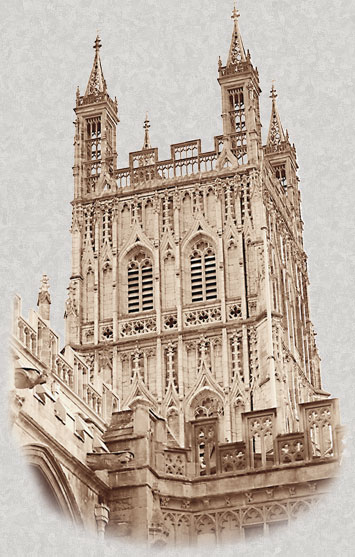
Gloucester Cathedral — of ghosts and skirret lines
Read more about the history of Gloucester Cathedral here.
The following account is extracted from an early draft of The Novice.
Gloucester Cathedral, just around the corner from the Worcester Street flat where I grew up, was my ultimate hideout – a refuge from those who for some reason couldn’t fathom me, and from whom I sought to hide.
The blood and sweat of history enrich the soil of Gloucester’s market gardens, but in the cathedral the bones of the rich and titled crumble peacefully. The huge limestone blocks, gargoyles and statuary were cut and laid by several generations of masons. Sons built massive cylindrical piers, chiselling devotedly along their fathers’ skirret lines, pioneering new types of vaulting.
I circumambulated the cathedral before entering, all the better to see its huge blackened sides. I grew familiar with it in the nineteen fifties, when the war was still blamed for everything. For years I trusted that the walls had been scorched by, and had repelled, German bombs. I was disappointed when I later learned that the Luftwaffe hadn’t the slightest interest in the pastoral West Country. The tarnish was more likely caused by the passing centuries, or even by passing traffic. Still, it added to the structure’s sense of immense age, as if it needed it, and prepared me to pass through its doors into its inner space. Here I was free of the observant eyes of family and teachers – and even of my God, for the Catholics had been ejected centuries before. And yet, although every stonily magnified footstep and echoed cough must have attracted the attention of fifty generations of Gloucester’s ghosts, I never minded being watched by them.
The cathedral was, among other things, a mausoleum. Countless stones were inscribed with the legend, “Here lies …,” usually followed by long family lists and often worn and polished beyond legibility. Walls, decorative devices and stained glass windows were inscribed with tributes to pious Abbots, Bishops and families of the borough. Near the main altar, the murdered King Edward II lies beneath his impressive but strangely diminutive effigy. Were people really so small in those days?

The cathedral tower has dominated
Gloucester’s skyline since the fifteenth century
The door to the tower was usually locked, but not always. The countless forbidden stairs led to the huge belfry but didn’t stop there. At the very top of the tower I could never pinpoint our house. From up there, with delicious shivers running up and down my spine, all I saw was a medieval town.
